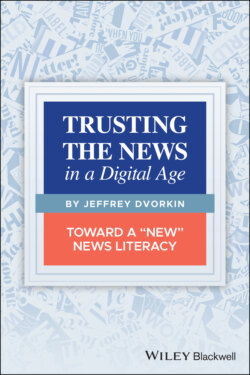Читать книгу Trusting the News in a Digital Age - Jeffrey Dvorkin - Страница 5
1 Introduction to News Literacy TAKEAWAYS FROM CHAPTER 1
Оглавление1 What you will find in each chapter
2 What “news literacy” is and how it differs from “media literacy”
3 Why news literacy matters now
4 How we achieve news literacy
5 What we can do with news literacy
6 What happens when we are “news illiterate”
The flow of information that surrounds us all the time can be overwhelming.
From cellphones, to broadcasting, to online content, blogs, and newspapers, we are surrounded by so much technologically delivered content that it can be difficult to determine what is useful and what is not. For many people, it is more than can be handled, and we are seeing a withdrawal from engaging with the news.
Finding a way to handle this ebb of engagement in an analytic and thoughtful way is essential to our living in this contemporary world. We need to know what and who we can trust, what should be shared, and how to engage with the news in a way that serves us as students, as citizens, and as journalists.
We will be examining these issues in this book. In Chapter 2, we will look at how the definition of news in a digital age has changed
The ethical obligations of the news will be examined in Chapter 3.
In Chapter 4, we'll examine how verification is the essential element of reliable journalism.
In Chapter 5, we will examine how the news changes across different media platforms.
The role of news consumers and the interaction between the public and the news media are the subjects of Chapter 6.
In Chapter 7, we will look at bias in the media.
Chapter 8 will examine the economics of news and how we arrived in this period of information saturation.
The deconstruction of news assumptions and the use of framing techniques will be examined in Chapter 9.
Chapter 10 will examine how digital culture has had an impact on the connection between the news and the law.
Finally, in Chapter 11, we will look at how accusations of “fake news” are usually, in and of themselves, fake, and how news consumers, journalists, and students can manage these allegations effectively.
These changes in communication continue to be enormous in their implications. We need to look at the economic and technological conditions that have allowed these changes to occur – sometimes in a beneficial way and often with disruptions to the way things used to be.
But first we need to define what we are looking at. It is through these broad but essential definitions that we can start to place this information flow in a historical and cultural context that makes sense for us.
